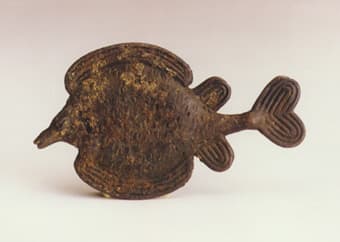Asante Brass Goldweight in the Form of a Fish, 19th Century CE - 20th Century CE
Brass
4.375 x 2.625
PF.4432 (LSO)
This attractive piece is a gold-weight made by one of the tribes of the Akan group, from modern-day Ghana. It depicts a long-snouted fish with a wide body, two pairs...
This attractive piece is a gold-weight made by one of the tribes of the Akan group, from modern-day Ghana. It depicts a long-snouted fish with a wide body, two pairs of dorsal fins, and a rounded tail. The patina is very dark.
The Akan are a loose assemblage of tribes – including the Akuapem, the Akyem, the Ashanti, the Baoulé, the Anyi, the Brong, the Fante and the Nzema – that share general cultural trends while maintaining separate tribal identities. Their society is highly ritualised, with a main deity, and a host of lesser gods that are connected with the natural world. The society is ruled by Asantahenes, and a host of minor chiefs.
Akan gold-weights reflect the polity’s obsession with the precious metal. The Akan consider gold to be the embodiment of sunlight and a physical manifestation of life’s vital force, or “kra”. It underpins the economy, and is used for the manufacture of royal regalia and many aspects of elite life. The weights themselves are based upon a measurement system that originated in Mesopotamia some 4000 years ago, and which has been transported via numerous empires to West Africa. While weight-formalised, they are also used to express proverbs and social histories, and are made in a vast array of shapes. They have been manufactured here for at least 500 years.
Fish weights are usually made in the form of sawfish, sunfish and other species that were considered sacred – and therefore could not be eaten – in various parts of the Akan region. This weight is most likely to be Ashante. It is a charming piece of African art and social context.
The Akan are a loose assemblage of tribes – including the Akuapem, the Akyem, the Ashanti, the Baoulé, the Anyi, the Brong, the Fante and the Nzema – that share general cultural trends while maintaining separate tribal identities. Their society is highly ritualised, with a main deity, and a host of lesser gods that are connected with the natural world. The society is ruled by Asantahenes, and a host of minor chiefs.
Akan gold-weights reflect the polity’s obsession with the precious metal. The Akan consider gold to be the embodiment of sunlight and a physical manifestation of life’s vital force, or “kra”. It underpins the economy, and is used for the manufacture of royal regalia and many aspects of elite life. The weights themselves are based upon a measurement system that originated in Mesopotamia some 4000 years ago, and which has been transported via numerous empires to West Africa. While weight-formalised, they are also used to express proverbs and social histories, and are made in a vast array of shapes. They have been manufactured here for at least 500 years.
Fish weights are usually made in the form of sawfish, sunfish and other species that were considered sacred – and therefore could not be eaten – in various parts of the Akan region. This weight is most likely to be Ashante. It is a charming piece of African art and social context.
